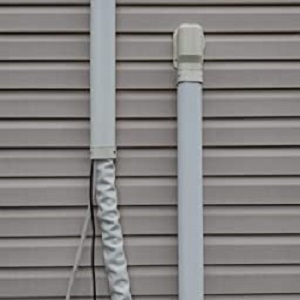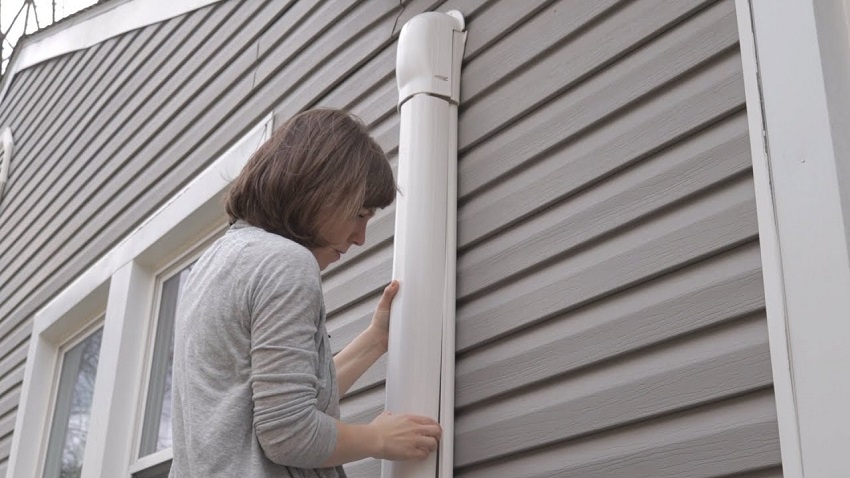Want to know how the neighbor’s managed to hide their PVC pipes? You can hide it by painting, covering or building trellis around it. These techniques are all easy to apply. It isn’t only hide the pipe but also enhance the beauty of your home.
So, how to hide PVC pipe outside? There are a lot of ways to hide your pipes. You can apply following techniques;
- Painting it to match the surroundings
- Installing a decorative cover
- Planting shrubs or building a trellis around it
- Installing PVC covers or burying it underground
In this article, we’ll look at several ways to hide PVC pipes outside your home and tell you about the benefits and drawbacks of hiding PVC pipes outside. Now let’s get started!
What Are The Methods For Hiding Plumbing Pipes Outside?
You can use a variety of techniques to hide PVC pipe outside and keep your outside area looking neat and organized. Some of the basic methods are listed in the table below:
| Methods | Description |
| Painting PVC pipes | Paint the PVC pipes to complement your home’s exterior or the surrounding scenery |
| Using natural camouflage | The PVC pipes can be covered with natural-looking materials like grass, rocks, or stones |
| Burying the PVC pipe underground | You can bury the PVC pipes underground, by digging a trench and placing the pipes inside |
| Install decorative elements | To conceal the PVC pipes and detract attention from them, use decorative items like statues or vases |
| Cover with plants | Plants can be used to conceal PVC pipes by either planting them close to the pipes or setting potted plants next to them |
| Use PVC pipe covers | Get PVC pipe covers that are designed to conceal the pipes |

How to Hide PVC Pipe Outside? In-Depth Guide
The following section covers all the mentioned methods in detail.
Painting PVC pipes
Painting PVC pipes is a cost-effective and simple method for hiding pipes. That can blend in with the surroundings and create a more aesthetically pleasing outdoor environment.
However, you should use paint that is intended for use on plastic surfaces to be sure the paint will hold properly and not chip or peel. Moreover, it’s recommended to pick a light color for the paint. Because dark hues may absorb too much heat, causing the PVC pipes to expand and maybe distort.
The steps you can take to paint PVC pipes are as follows:
Step 1: Make sure to wash the PVC pipes thoroughly with soap and water before painting them.
Step 2: Next, sand the pipes’ surface to make it rougher so that the paint will stick to it better.
Step 3: Afterward, paint the pipes with a coat of primer made for plastic surfaces and allow them to dry completely.
Step 4: Once the primer has dried, apply a coat of paint in the desired color to the pipes.
Using Natural Camouflage
An easy and sustainable technique to conceal PVC pipes is by using natural camouflage. It can give your outdoor area a more natural appearance and help the pipes blend in with the landscape.
- You can start by gathering rocks, stones, branches, or other natural objects whose colors resemble the surrounding environment.
- Stack the materials around the PVC pipes to create a cover that blends in with the surroundings.
- You can also use larger rocks or create a rock garden around the pipes to create a more natural look.
- It’s crucial to make sure the natural materials are positioned tightly around the pipes to prevent shifting or movement over time. To hold the components together, you can use wire ties or construction cement.
How to Hide Drain Pipes Underground
PVC pipes can be buried underground using a technique called trench burying, which entails digging a trench and putting the pipes inside. This technique works best with pipes that are not commonly accessed, such as irrigation or drainage pipes.
You can bury PVC pipes underground by following these basic steps:
Step 1: You need to decide where and how deep the trench should be based on how the PVC pipes are going to be used. For instance, if the pipes are for irrigation, they might need to be buried shallower than for plumbing.
Step 2: After that, you must dig the trench to the required depth and width with a shovel.
Step 3: The PVC pipes should then be cut to the correct length and both ends should be cleaned well to remove any dirt or debris.
Step 4: As you place the PVC pipes in the trench, pay attention to their alignment. Use a PVC elbow fitting if you need to make a turn.
Step 5: Now, connect the pipes using PVC connectors. Then, firmly press the connectors and pipes together after applying PVC cement to both surfaces.
Step 6: You must fill the trench with dirt and soil after installing and coupling the PVC pipes. To prevent pipes from shifting or settling over time, you must make sure the soil is well-packed around them.
Step 7: Make sure the pipes are buried deep enough to keep them from being damaged by lawn mowers or other landscaping tools. You can also mark the location of the pipes with flags to ensure that they are not accidentally dug up in the future.
Install Decorative Elements
A versatile way to conceal PVC pipes that can make an outdoor environment more aesthetically appealing is by installing decorative features.
- You can surround the PVC pipes with aesthetic components like trellises, fencing, decorative screens, wooden benches, and garden beds.
- These components can be constructed of vinyl, metal, or wood and can be painted to match the surroundings.
- For a more natural appearance, you can also include climbing plants with decorative items.
- Another option is to surround the PVC pipes with a pathway made of ornamental rocks or a decorative rock garden. You can use this technique to both hide the PVC pipes and beautify the outdoor area.
Make sure the decorative components won’t obstruct access to the pipes or interfere with their operation before you install them.
Cover the PVC Pipes with Plants
Plants can be used to cover PVC pipes in a natural and eco-friendly way. It can also have additional advantages like increasing air quality and preventing soil erosion. Follow the steps to apply this method.
Step 1: Choose plants that are appropriate for your backyard’s surroundings and climate before covering PVC pipes with them.
Step 2: Use climbing plants that can naturally cover the pipes and grow around them, such as Ivy, Climbing roses, Wisteria and Clematis.
Step 3: After choosing your plants, put them around the PVC pipes and give them something to climb on, like trellises or wires. As the plants grow, they will create a natural cover around the PVC pipes, blending them with the surrounding environment.
Step 4: You should maintain the plants by routinely trimming them to prevent them from going out of control and hindering the operation of the pipes.
How to Cover External Plumbing Pipes
This is an effortless and hassle-free way to conceal PVC pipes. You can get pre-made covers at a hardware store that are the right size for your PVC pipes. These covers often come in a variety of colors and designs to blend in with the surroundings and are made of sturdy materials like plastic or vinyl.
After purchasing the covers, just install them over the PVC pipes and make sure they fit the pipes securely.
Watch the YouTube video to learn how to install PVC pipe covers.
Advantage and Disadvantage of Hiding PVC Pipes Outside
You should be aware of the benefits and drawbacks of hiding PVC pipes before implementing any of the methods mentioned above. A general overview of the pros and cons of hiding PVC pipes is provided below.
Pros
- Protect against rain and wind and other potential damage
- Due to architectural improvements, the property value may rise
- Provides more privacy
- Decreases the possibility of tripping to ensure safety
- Enhances the outdoor area’s aesthetic appeal
Cons
- Limited access to pipes for maintenance or repair
- You need to bear the cost of labor and supplies
- Lengthy installation procedure
- The decorative elements may get damaged over time
Frequently Asked Questions
Here are some frequently asked questions about hiding PVC pipe outside:
Q: Will hiding PVC pipe outside affect its durability or lifespan?
The durability and lifespan of PVC pipe should not be affected by hiding it outside. PVC pipe is frequently used for outdoor plumbing applications since it is made to endure exposure to excess heat or pressure.
Q: Do I need to be concerned about any safety issues when hiding PVC pipe outside?
Yes. Use safety barriers if you’re hiding PVC pipe in a place where it can be damaged by impact or other factors. This will help avoid accidents. To protect the pipe from unintentional damage by lawnmowers, or other equipment, it is recommended to put up a fence or other barrier around the area.
Q: Should I be aware of any laws or building rules before burying PVC pipes outside?
Yes, you may need to adhere to rules and building laws when burying PVC pipes outside. If you plan to bury the pipes underground, you may need to obtain permits from your local building department.
Some localities have precise guidelines for how far the pipe must be buried and what kind of bedding material must be used.
Final Words
In conclusion, hiding PVC pipe outside can be a terrific way to enhance the visual appeal of your house and safeguard your plumbing. Whether you choose to bury the pipe underground, use decorative materials to camouflage it, or install a cover, there are many creative and effective ways to hide PVC pipe outside.
If you’re unsure about where to begin, consider speaking with a qualified plumber. They can assist you in making sure your project is executed safely and properly and provide insightful suggestions. With the right tools, knowledge, and creativity, you can change the look of your outdoor area.

